

World Health Organization (WHO) WHO remains firmly committed to the principles set out in the preamble to the Constitution. Ottawa Charter for Health Promotion. November 17-21, 1986 Ottawa, Ontario, Canada This charter is also available for downloading or viewing:Ottawa Charter for Health Promotion (PDF document - 192 KB - 5 pages) The first International Conference on Health Promotion, meeting in Ottawa this 21st day of November 1986, hereby presents this CHARTER for action to achieve Health for All by the year 2000 and beyond.
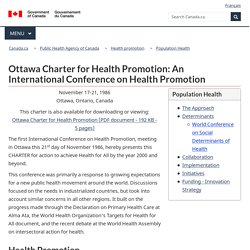
This conference was primarily a response to growing expectations for a new public health movement around the world. Discussions focused on the needs in industrialized countries, but took into account similar concerns in all other regions. Understanding Key Health Inequalities in Canada. Canadians are among the healthiest people in the world.
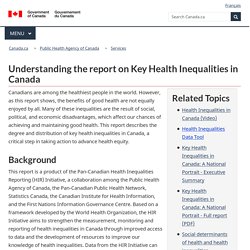
However, as this report shows, the benefits of good health are not equally enjoyed by all. Many of these inequalities are the result of social, political, and economic disadvantages, which affect our chances of achieving and maintaining good health. This report describes the degree and distribution of key health inequalities in Canada, a critical step in taking action to advance health equity. Background This report is a product of the Pan-Canadian Health Inequalities Reporting (HIR) Initiative, a collaboration among the Public Health Agency of Canada, the Pan-Canadian Public Health Network, Statistics Canada, the Canadian Institute for Health Information, and the First Nations Information Governance Centre. Social Determinants of Health. Our mental health is influenced by many factors including life experiences, workplace or other environments, and the social and economic conditions that shape our lives.
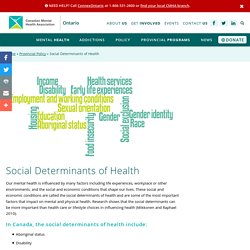
These social and economic conditions are called the social determinants of health and are some of the most important factors that impact on mental and physical health. Research shows that the social determinants can be more important than health care or lifestyle choices in influencing health (Mikkonen and Raphael 2010). Social Determinants of Health and Health Inequalities. Determinants of health are the broad range of personal, social, economic and environmental factors that determine individual and population health.
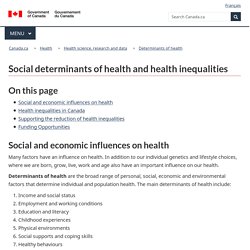
The main determinants of health include: Social Determinants of Health. The Canadian Facts - SDOH. Government of Canada - SDOH. Our Cities, Our Health, Our Future - SDOH. Ontario Public Health Association - SDOH. RNAO SDOH. CNA & SDOH. In all countries, it is well-established that poorer people have substantially shorter life expectancies and more illnesses than the rich — inequalities that cannot be explained by differences in health care or by personal health behaviours.
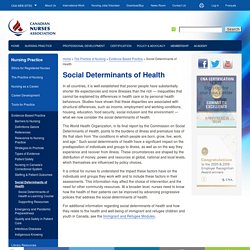
Canadian Public Health Association (CPHA) & SDOH. The social determinants of health (SDH) are the social and economic factors that influence people's health. These are apparent in the living and working conditions that people experience every day. The SDH influence health in many positive and negative ways. Extreme differences in income and wealth, for example, have negative health consequences for those who are living in poverty and these effects are magnified when these people are congregated in poor regions. SDOH Initiatives. Using the SDOH as a Framework to Examine and Address Predictors of Depression in Later Life. SDOH and Implications for children's health. SDOH for Indigenous People's Health. SDOH Residential School Sytem and Colonialism. SDOH Wellesley Institute. SDOH and Girls and Women's Health.
Canada Health Act. Healthcare in Ontario: How does it Work and How is it Funded? The healthcare system in Ontario can be confusing, and most people don’t quite understand how it works and how it’s funded.

We pay our taxes, but then what happens? Where does that money go, and how does it impact our healthcare system? This guide will help answer those questions in a simple, easy-to-understand way. The following flow chart provides a summary of the major Operating Expenses for the MOHLTC along with their sub-category expenses. Don’t worry, this will all be explained below! View Larger. Canada's Health Care System. Table of Contents Introduction Canada's publicly funded health care system is dynamic--reforms have been made over the past four decades and will continue in response to changes within medicine and throughout society.
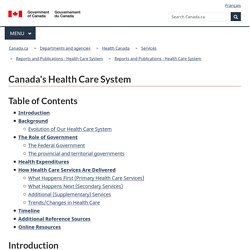
The basics, however, remain the same--universal coverage for medically necessary health care services provided on the basis of need, rather than the ability to pay. Public Health Agency of Canada (PHAC) Regulated Health Professions Act, 1991 (RHPA) The Regulated Health Professions Act, 1991 (RHPA), and associated health profession Acts, set out the governing framework for the regulated health professions in Ontario.
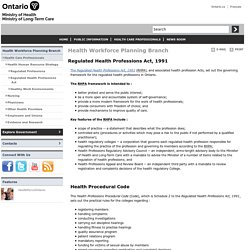
The RHPA framework is intended to : better protect and serve the public interest; be a more open and accountable system of self-governance; provide a more modern framework for the work of health professionals; provide consumers with freedom of choice; and provide mechanisms to improve quality of care. Key features of the RHPA include : Health Procedural Code The Health Professions Procedural Code (Code), which is Schedule 2 to the Regulated Health Professions Act, 1991, sets out the practical rules for the colleges regarding : The Code is embedded into each health profession Act (i.e. the Chiropractic Act, 1991).
Regulated Health Professions. Audiology and Speech-Language Pathology Audiologists assess hearing and treat and prevent hearing problems to develop, maintain, rehabilitate or augment hearing and communication functions.
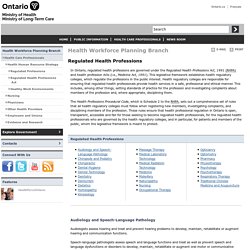
Speech-language pathologists assess speech and language functions and treat as well as prevent speech and language dysfunctions or disorders to develop, maintain, rehabilitate or augment oral motor or communicative functions. Chiropody and Podiatry Chiropodists and podiatrists treat and prevent diseases, disorders or dysfunctions of the foot by therapeutic, orthotic or palliative means. Chiropodists are allowed to cut into the subcutaneous tissues of the foot, prescribe drugs designated in the regulations and inject into the feet a substance set out in the regulations. Podiatrists also treat and prevent diseases, disorders and dysfunctions of the foot by therapeutic, orthotic or palliative means. Chiropractic Chiropractors assess conditions related to the spine, nervous system and joints. Ontario Ministry of Health and Long-Term Care. OHIP. Health care in Ontario OHIP is Ontario’s health care plan. Through OHIP, the province pays for many of the health services you may need.
You need to apply and, once you’re approved, you’ll get an Ontario health card. Your health card proves you’re covered by OHIP – that’s why you’ll need to show it every time you see your doctor, visit an emergency room, have a medical test or go for surgery. What’s covered OHIP covers many health services you may need, such as: appointments with your family doctor visits to walk-in clinics and some other health care providers visits to an emergency room medical tests and surgeries To be covered by OHIP, you must have a medical reason to receive a service or treatment. Learn more about OHIP-covered services and products. Who qualifies To qualify for OHIP, you must meet all of the minimum qualifications listed below plus at least one of the additional requirements. To meet the minimum qualifications you must: Health Care Consent Act, 1996 (HCCA) Health Care Consent Act, 1996 S.O. 1996, Chapter 2 Schedule A Consolidation Period: From July 8, 2020 to the e-Laws currency date.
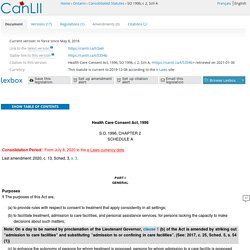
Purposes 1 The purposes of this Act are, (a) to provide rules with respect to consent to treatment that apply consistently in all settings; (b) to facilitate treatment, admission to care facilities, and personal assistance services, for persons lacking the capacity to make decisions about such matters; Note: On a day to be named by proclamation of the Lieutenant Governor, clause 1 (b) of the Act is amended by striking out “admission to care facilities” and substituting “admission to or confining in care facilities”.
(c) to enhance the autonomy of persons for whom treatment is proposed, persons for whom admission to a care facility is proposed and persons who are to receive personal assistance services by, (i) allowing those who have been found to be incapable to apply to a tribunal for a review of the finding, Interpretation. Nursing Act, 1991. Nursing Act, 1991 Consolidation Period: From December 30, 2017 to the e-Laws currency date. Definitions “College” means the College of Nurses of Ontario; (“Ordre”) “Executive Director” means the Registrar; (“directeur général”) Toronto Central Local Health Integration Network (LHIN) Public Health Ontario. Freedom of Information and Protection of Privacy Act, 1990 (FIPPA)
Freedom of Information and Protection of Privacy Act Consolidation Period: From July 8, 2020 to the e-Laws currency date. Purposes 1 The purposes of this Act are, (a) to provide a right of access to information under the control of institutions in accordance with the principles that, College of Nurses of Ontario (CNO) Registered Nurses' Association of Ontario (RNAO) Ontario Nurses Association (ONA) Canadian Nurses' Association (CNA) Canadian Federation of Mental Health Nurses (CFMHN) Canadian Institute for Health Information (CIHI) July 30, 2020 — Our report examines the transformations that have occurred in Canada’s 4 groups of regulated nursing professionals. All groups work both independently and in collaboration with health care teams to provide care to individuals.
Canada’s nursing workforce includes nurse practitioners (NPs), registered nurses (RNs), registered psychiatric nurses (RPNs) and licensed practical nurses (LPNs). Each province and territory has its own legislation governing nursing practice, as well as its own body that regulates and licenses its members. Closing the Gap (CTG) Healthcare. The Mental Health Act (MHA) Centre for Addiction and Mental Health (CAMH) Canadian Mental Health Association (CMHA) MHA Forms. Psychiatric Patient Advocate Office (PPAO) Mental Health Commission of Canada (MHCC) ConnexOntario. Canadian Civil Liberties Association (CCLA) Because the Learn section of TalkRights features content produced by CCLA volunteers and interviews with experts in their own words, opinions expressed here do not necessarily represent the CCLA’s own policies or positions.
For official publications, key reports, position papers, legal documentation, and up-to-date news about the CCLA’s work check out the In Focus section of our website. Public Health Ontario.